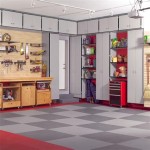```html
Maximizing Garage Space With Above Door Shelving System
Garages often become repositories for items that lack a designated place within the home. This ease of access, coupled with their typically substantial square footage, can lead to clutter and a severely compromised workspace. Employing strategic storage solutions is crucial to reclaiming garage space and transforming it into a functional and organized area. An above-door shelving system offers a particularly effective method for capitalizing on often-underutilized vertical space.
This type of shelving system leverages the area above the garage door opening, a space that is rarely utilized for storage. Due to the operational clearance required for the garage door, this area often remains empty, representing a significant amount of wasted potential. Installing shelving in this zone allows for the storage of items that are infrequently needed but still require accessible storage within the garage environment. This allows valuable floor space to be freed up for parking vehicles, working on projects, or other activities.
Consider the typical contents of a garage: seasonal decorations, sporting equipment, camping gear, and gardening supplies are just a few examples of items that might be stored. These items are not used daily, and their storage on the floor or on easily accessible shelves can contribute to clutter and disorganization. An above-door shelving system provides an ideal space to house these less frequently used items, keeping them out of the way while remaining accessible when needed.
The implementation of an above-door shelving system requires careful planning and execution to ensure safety and functionality. The following considerations are paramount when selecting, installing, and utilizing this type of storage solution.
Assessing Load Capacity and Structural Integrity
The primary concern when installing any shelving system, particularly one suspended above a doorway, is the load capacity of both the shelving itself and the supporting structure. Garage walls are typically constructed of drywall over studs, and these studs are essential for providing adequate support for the shelving. Identifying the stud locations is crucial for secure mounting.
The weight-bearing capacity of the drywall alone is insufficient for supporting substantial loads. Therefore, the shelving brackets must be securely attached to the studs using appropriate hardware. Lag bolts or heavy-duty screws are generally recommended for this purpose, as they provide a strong and reliable connection. The size and type of fastener will depend on the expected load and the material of the studs (wood or metal).
Before installing the shelves, it is imperative to determine the total weight the system will need to support. This involves assessing the weight of the shelving materials themselves (metal, wood, or composite) and the anticipated weight of the items to be stored. It is advisable to overestimate the weight to provide a safety margin and prevent overloading. The shelving manufacturer's specifications will provide information on the maximum load capacity per shelf. This must be carefully adhered to.
Additionally, the structural integrity of the garage wall itself needs to be evaluated. In older garages, the studs may be weakened by rot, insect damage, or previous modifications. If any signs of structural compromise are evident, it is essential to consult with a qualified contractor or structural engineer before proceeding with the shelving installation. Reinforcing the wall may be necessary to ensure the safety and stability of the system.
The type of shelving material also plays a crucial role in load capacity. Solid wood shelves are generally stronger than particleboard or MDF shelves. Metal shelving, particularly steel, offers exceptional strength and durability. When selecting shelving materials, consider the weight of the items to be stored and choose a material that can safely support that weight without sagging or bending.
Selecting the Right Shelving Configuration and Materials
The configuration of the shelving system should be tailored to the specific storage needs and the dimensions of the space above the garage door. Several factors influence the optimal configuration, including the height of the garage ceiling, the height of the garage door when fully open, and the type of items to be stored.
Adjustable shelving systems offer flexibility in accommodating items of varying heights. These systems typically consist of vertical tracks or standards that are mounted to the wall studs, with brackets that can be repositioned along the tracks. This allows for customization of shelf spacing to maximize vertical space utilization. Fixed shelving systems, on the other hand, offer less flexibility but may be more cost-effective for storing items of uniform height.
The depth of the shelves should also be considered. Deeper shelves provide more storage space but may make it difficult to access items stored at the back. Shallower shelves are easier to access but offer less storage capacity. A balance must be struck between accessibility and storage density.
The materials used for the shelving system should be durable, weather-resistant, and aesthetically pleasing. Metal shelving is a popular choice for garages due to its strength, durability, and resistance to moisture. Wood shelving offers a more traditional look and can be stained or painted to match the garage's décor. Composite shelving materials offer a compromise between strength, durability, and affordability.
When choosing shelving materials, consider the potential for exposure to moisture, temperature fluctuations, and pests. Garages are often subject to these conditions, which can damage certain materials over time. Treated lumber or metal with a rust-resistant coating is recommended for garages in humid climates.
Safety is paramount when selecting shelving materials. Avoid materials that are prone to splintering, cracking, or off-gassing harmful chemicals. Ensure that all materials are properly treated and finished to prevent injury or health hazards.
Implementing Safe Access and Organization Practices
Once the above-door shelving system is installed, developing and adhering to safe access and organization practices is crucial for preventing accidents and maximizing the system's effectiveness. Accessing items stored on high shelves requires the use of a sturdy ladder or step stool. Choosing the right ladder and employing safe climbing techniques are essential.
Select a ladder that is appropriately sized for the height of the shelves. The ladder should extend at least three feet above the top shelf to provide adequate support and prevent falls. Ensure the ladder is stable and level before climbing. Avoid leaning too far to the side while on the ladder, as this can cause it to tip over. Always maintain three points of contact with the ladder (two hands and one foot, or two feet and one hand) when climbing.
Consider using a rolling step stool with handrails for accessing lower shelves. These step stools provide a stable platform and can be easily moved around the garage. Avoid using chairs or other unstable objects as substitutes for a ladder or step stool.
Organizing the items on the shelves is essential for efficient storage and retrieval. Group similar items together and label the shelves clearly. Use clear plastic bins to store smaller items and prevent them from falling off the shelves. Rotate items periodically to bring less frequently used items to the front and more frequently used items to the back.
Avoid storing heavy or bulky items on the top shelves. These items are more difficult to lift and can pose a safety hazard if they fall. Store lighter items on the top shelves and heavier items on the lower shelves. Distribute the weight evenly across the shelves to prevent overloading and sagging.
Regularly inspect the shelving system for signs of damage or wear. Check the brackets, shelves, and fasteners for looseness, rust, or cracks. Repair or replace any damaged components immediately to prevent accidents. Ensure that the area around the shelving system is kept clear of clutter to prevent tripping hazards.
By carefully considering load capacity, selecting the right configuration and materials, and implementing safe access and organization practices, homeowners can effectively maximize garage space with an above-door shelving system. This can transform a cluttered and disorganized garage into a functional and efficient storage space.
```.jpg?strip=all)
How Can I Maximize Storage In My Small Garage Affordable Ceiling Racks

Diy Garage Ceiling Storage And Wall Organization Angela Marie Made

Ideas For Garage Storage How To Maximize Valuable Space

Innovative Garage Ceiling Storage Ideas By Smart Racks

Diy Garage Ceiling Storage And Wall Organization Angela Marie Made

How To Diy The Best Overhead Garage Storage South House Designs

Ideas For Garage Storage How To Maximize Valuable Space

Garage Storage Systems Maximize Your Space Diy Design Decor

Garage Ceiling Storage The Solution For Extra Space

The A Z Tips Of Space Saving Ideas Small Garage Storage
Related Posts








